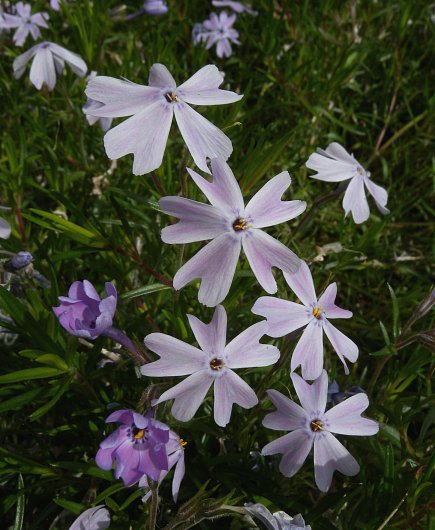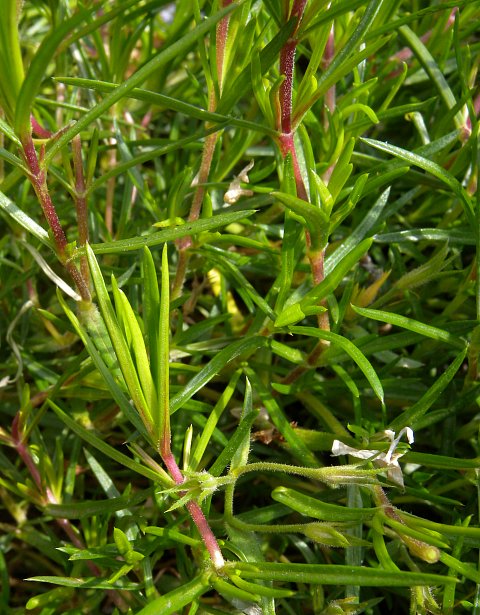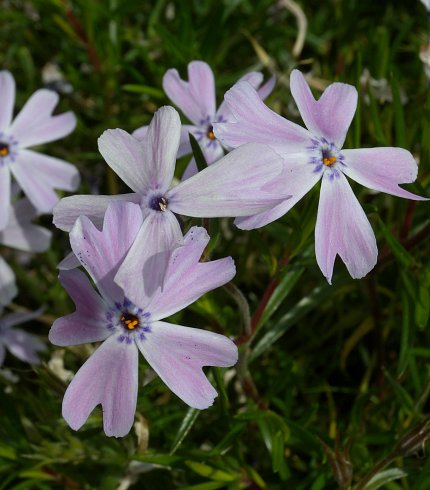
The corollas of the flowers are ½–¾" across and almost as long; they have narrowly tubular bases and 5 spreading lobes that are oblanceolate in shape and slightly to moderately notched. The corollas are purple, lavender, rosy pink, pink, white, or bicolored. The calyces are about ¼" long, light green to reddish purple, short-tubular with 5 slender teeth, and pubescent. Inserted within the narrow throat of each corolla, there are 5 stamens and a pistil with a single style. The hairs of the foliage and calyces can be glandular or non-glandular (usually the latter). The blooming period occurs during mid- to late spring for about 3-5 weeks. Afterwards, the flowers are replaced by small 3-valved seed capsules that are about 4 mm. long. Each capsule contains 3 or more seeds. The root system is fibrous. This plant spreads by reseeding itself. The foliage is semi-evergreen.
Cultivation: The preference is full sun, sandy or rocky soil, and dry conditions. This plant will adapt to ordinary garden soil containing loam, but good drainage is important.

Range & Habitat: Naturalized populations of Moss Phlox occur in widely scattered areas of Illinois, including the NE section of the state (see Distribution Map), where they are rare. Moss Phlox is native to the Appalachian mountains. This plant is often cultivated in flower gardens, from which it can escape. Habitats include sandy roadsides, sandy or gravelly areas along railroads, and rocky bluffs. In the Appalachian mountains, this is a conservative species that occurs on riverside outcrop prairies, shale glades, limestone glades, serpentine barrens, and rocky ledges of cliffs. It is not invasive in Illinois.
Faunal Associations: The flowers attract butterflies, skippers, and long-tongued bees. Nectar is the floral reward for these insects, although some of the bees also collect pollen. Steury et al. (2009) observed a mason bee, Osmia taurus, visiting the flowers of Moss Phlox at a riverside outcrop prairie in Virginia. The foliage, flowers, and/or seed capsules of Moss Phlox are eaten by some species of plant bugs (Miridae). This include 2 monophagous or oligophagous species, Polymerus tinctipes and Polymerus wheeleri, and 2 polyphagous species, Lopidea minor and Lopidea heidemanni (Wheeler, 1995).

Photographic Location: A flower garden at the Urbana Free Library in Urbana, Illinois.
Comments: Because of its low semi-evergreen foliage and attractive flowers, Moss Phlox is often cultivated along the borders of gardens. Many cultivars with differing flower colors have been developed and released to members of the public. Moss Phlox can be distinguished from other Phlox species by its narrow linear leaves and tendency to form low sprawling mats of foliage. Whereas other Phlox species have pairs of opposite leaves along their stems, the leaves of Moss Phlox usually occur in clusters, causing them to appear whorled. Other Phlox species are usually more erect with wider leaves; if secondary leaves are produced from the axils of their opposite leaves, they are less abundant.